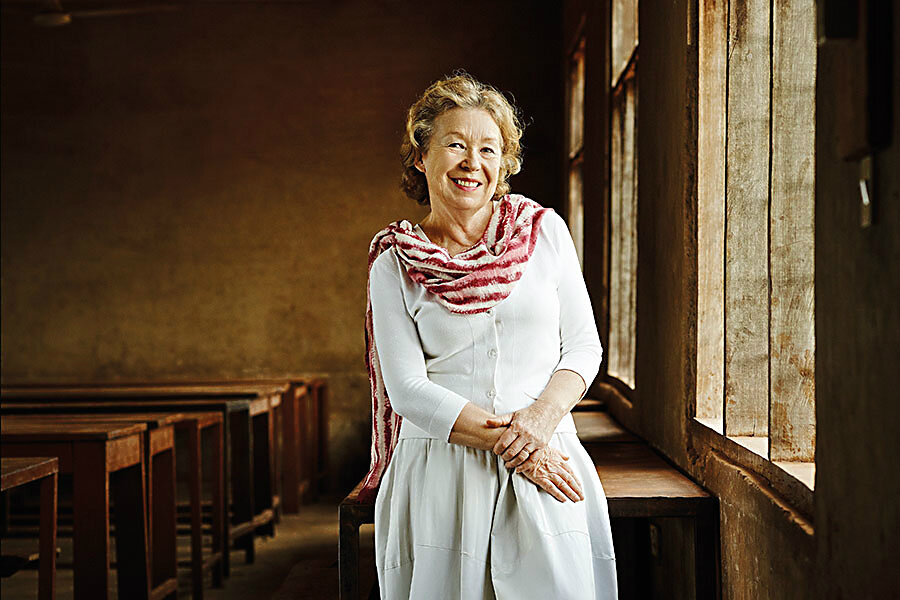Girls in Africa: one way that more of them are attending school
Loading...
When Ann Cotton was pursuing a master’s degree in the early 1990s, her studies on educational imbalances brought her to Zimbabwe.
She visited the country, characterized by racial segregation and low participation rates in education, with the goal of examining what advances had been made 10 years after it gained independence.
“I was asking why it was that rural girls were not making the progress of their male peers,” she says. “In the village where I was based, there were seven boys for every girl in secondary school.”
Ms. Cotton admits she held a preconception that was widely believed about sub-Saharan Africa – that female exclusion from education was driven by family resistance and cultural norms.
“What I found in that village really confounded that, challenged that,” she says. “I heard from everyone I spoke to that the reason girls weren’t at school was because of family poverty.”
Not long afterward, Cotton founded Camfed, an international nonprofit that works to support marginalized girls in sub-Saharan Africa so they can attend school, empowering them as future change agents and helping them to succeed.
Camfed, also known as the Campaign for Female Education, invests in girls and women, improves schools, and supports alumnae as they go on to become entrepreneurs and community leaders.
According to Camfed, in 2015 alone more than 500,000 girls received support from the organization to attend school, with more than 2.5 million children benefiting from improved learning environments in Zimbabwe, Zambia, Ghana, Tanzania, and Malawi. Since Camfed’s founding in 1993, a total of 1.6 million girls have received support for their education.
“My response was to a particular community,” says Cotton, who hadn’t anticipated such numbers when she started Camfed. “It was also an intellectual response to the evidence about what education could deliver.”
Cotton’s research revealed the calculated decision that impoverished families made – to foot the cost of books and other school expenses only for boys, given their future earning potential in that society. She was moved to try to help not only the girls she encountered in Zimbabwe, but also many others like them.
“I thought the only way to demonstrate this is to do it – to actually support girls in school,” Cotton says. “I [built] a practical response to the problem of girls’ exclusion from education.”
Camfed’s support for girls can cover everything from school fees to uniforms to sanitary products. The girls who are most in need are guaranteed the chance to attend secondary school.
Camfed’s effect continues beyond graduation through CAMA, the organization’s alumnae association. The network, projected to have some 130,000 members by 2019, partners with donors and rural communities to offer training, mentoring, business loans, and technology to young women as they leave secondary school. Nearly 15,000 women have established businesses thanks to Camfed since 1993, with 1,980 just in 2015.
When discussing the results of Camfed, Cotton points to Angeline Murimirwa, one of the first recipients of educational support who is now regional executive director for Camfed’s programs in Malawi, Tanzania, Zambia, and Zimbabwe. “She is an example of someone who is now on the global stage fighting for global education,” Cotton says.
Ms. Murimirwa describes Camfed as giving her “the freedom to be a child once again” by allowing her to focus on school without having to worry about the cost – something that had previously halted her educational ambitions.
“The organization gives girls, families, communities, and nations the opportunity and the resources to break the cycle of poverty with dignity and pride,” she says. “It ignites action for change from within and without the most marginalized communities....”
Sally Osberg is president and chief executive officer of the Skoll Foundation, which supports social entrepreneurs and innovators and has invested in Camfed over the past decade.
“While a number of [nongovernmental organizations] provide scholarships, none commits to the ongoing support that enables a child to go as far as she can – from primary to secondary and even university education,” says Ms. Osberg in an email. “From the very beginning, Ann understood the potential to cultivate the assets even the poorest African communities possess: it’s their knowledge, institutional, and social capital that Camfed sees and values, and which forms the bedrock of its approach.”
Cotton, who lives in Britain, hopes that societies will begin to change attitudes toward poor people – and recognize the different forms of capital they can contribute.
“That was my starting point, really, with Camfed,” she says. “I saw the desire on the part of parents to send their daughters to school, [and] the commitment of communities to change.”
She adds, “It is not a neutral thing not to invest in education.”







